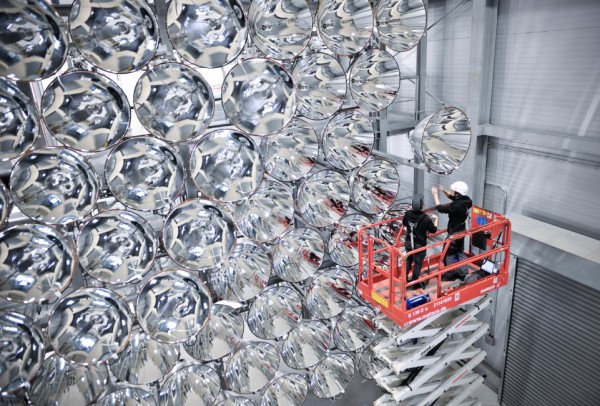By Ana Verayo, | March 26, 2017

The world's biggest solar simulator is located at the DLR facility in Jülich.
Scientists just revealed the "world's biggest artificial sun" and it's officially turned on. This massive structure can help in the technological development of green energies and fuels in the future, according to German scientists and engineers.
This artificial sun is composed of 149 spotlights, all placed in a honeycomb pattern which is known as Synlight. Each individual spotlight is actually a type of xenon short-arc lamp that are often utilized as cinema projectors, that is now used to simulate sunlight. If all 149 of these lights are concentrated into one single spot, this can apparently create 10,000 times as much solar radiation as opposed to a regular sunny spot.
Like Us on Facebook
In Germany, such light energy is pretty rare this time of the year which made scientists to explore and test new ways to create hydrogen and explore cleaner, greener energy sources. According to Bernhard Hoffschmidt who is the director of the DLR's Institute for Solar Research, to test new ways to develop hydrogen, scientists need to create conditions of temperatures of up to 3,000 degrees Celsius which is similar to a furnace. Hydrogen fuel is the next step when it comes to green energy since it does not produce any carbon emissions upon burning. Ultimately, this will not further add to the effects of global warming.
The most common element in the universe is hydrogen however, pure hydrogen is highly rare on Earth. Using a technique called electrolysis, hydrogen can be artificially created by splitting water into two components, which can separate oxygen with the help of electricity.
With this new artificial sun, researchers can now skip this electricity process by studying the massive amount of energy that reaches Earth via sunlight and solar energy. Hoffschmidt explains that this massive amount of energy is crucial in mastering new hydrogen making techniques with Synlight's 350 kilowatt array. This also means that this can also be increased tenfold to function in industrial levels in just a decade.
However, Hoffschmidt adds that despite this promising new source of renewable energy, hydrogen is still extremely volatile. If scientists can combine this with carbon monoxide that is produced via renewable sources, this would allow them to develop eco-friendly fuel as well.
-
Use of Coronavirus Pandemic Drones Raises Privacy Concerns: Drones Spread Fear, Local Officials Say

-
Coronavirus Hampers The Delivery Of Lockheed Martin F-35 Stealth Fighters For 2020

-
Instagram Speeds Up Plans to Add Account Memorialization Feature Due to COVID-19 Deaths

-
NASA: Perseverance Plans to Bring 'Mars Rock' to Earth in 2031

-
600 Dead And 3,000 In The Hospital as Iranians Believed Drinking High-Concentrations of Alcohol Can Cure The Coronavirus

-
600 Dead And 3,000 In The Hospital as Iranians Believed Drinking High-Concentrations of Alcohol Can Cure The Coronavirus

-
COVID-19: Doctors, Nurses Use Virtual Reality to Learn New Skills in Treating Coronavirus Patients







